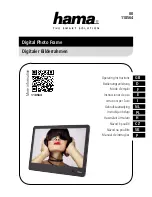
Using Encoders with Line Scan Cameras
3
80
MVS-8600 Hardware Manual
Encoder Characteristics
The design of your vision system will determine the most appropriate encoder type for
your application. In general, the encoder type most useful for the machine vision
component of a factory automation system is likely to be a
dual-channel quadrature
incremental rotary encoder
. The important characteristics of this encoder type are
described below:
•
A
rotary encoder
measures the number of revolutions of a spinning shaft or tube.
You can attach a measuring wheel to the shaft, and place the wheel against a
conveyor system to translate the conveyor’s linear motion into the encoder’s rotary
measurements. A rotary encoder’s output is specified in cycles per revolution
(CPR).
•
An
incremental encoder
produces a series of cyclically repeating pulses. One full
revolution of a rotary incremental encoder produces the same number of pulses
every time. An incremental encoder’s important output is the number of cycles
produced, not the position of the encoder shaft. (By contrast, an
absolute encoder
produces a unique x-y value, such as a voltage or a binary count, for each
mechanical position.)
•
A
dual-channel incremental encoder
supplies two sets of incremental output data.
One of the two encoder channels generally leads the other by 90 degrees, which
puts the two channels in quadrature relationship to each other. By convention, two
encoder channels are referred to as channel A and B.
•
Incremental encoders might provide an
index pulse
in addition to their A and B
channel output. The index pulse provides an absolute reference point for the
encoder’s spin, referred to as the center, home, or reset position of the encoder. By
convention, the index pulse is called the Z channel. The MVS-8600 does not
support the index pulse.
•
A
quadrature dual-channel encoder
is used for measuring bidirectional motion.
Because the two channels are in quadrature relationship (90 degree phase offset),
the system can monitor the phase relationship between the two channels to
determine the direction of motion.
Encoder Electrical Interface
This section describes the electrical characteristics of encoders that are best suited to,
and compatible with, MVS-8600 frame grabbers used in line scan applications. The
MVS-8600 is capable of supporting many types of encoders, but not all meet the
electrical voltage and signal requirements. There are many types of rotary and linear
encoders available with a wide variety of electrical characteristics. Use this section as a
Содержание MVS-8000 Series
Страница 1: ...Cognex MVS 8000 Series MVS 8600 Hardware Manual September 2012...
Страница 6: ...Contents 6 MVS 8600 Hardware Manual...
Страница 10: ...Preface 10 MVS 8600 Hardware Manual NOTES...
Страница 42: ...MVS 8600 Installation 1 42 MVS 8600 Hardware Manual...
Страница 78: ...MVS 8600 Hardware 2 78 MVS 8600 Hardware Manual...







































